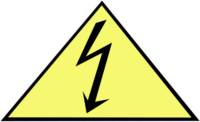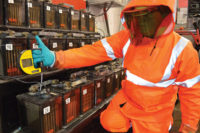What are insulated tools?
Insulated tool are designed for safety and are rated for live use up to 1000 VAC or 1500 VDC. These tools are manufactured according to strict standards. The ASTM (American Society of Testing and Materials) F1505, Standard for Insulating and Insulated Hand Tools, provides detailed information. Insulated hand tools should be manufactured and tested to this specification before approved for sale and use. Shape, size and usability can vary between manufacturers, thus the overall performance is based on the adequate design of the tool. Commonly seen in the market is a two-color design that can visually indicate that a tool has been damaged.
Who should use insulated tools?
Anyone working on or near energized exposed conductors or circuit parts where a hand tool is required should use insulated tools. Examples:
- Skilled Professionals (HVAC or Battery Maintenance Technicians)
- Electricians (Commercial or Industrial)
- Utility Workers (Metermen, Nuclear, Substation, Line & Switchgear)
- Renewables / Green Energy Market (Solar, Wind & Electric Cars)
Why are insulated tools available?
The NFPA (National Fire Protection Association) created NFPA 70E, the standard for electrical safety in the workplace. Within this standard are answers as to USE of, DEFINITIONS explaining, and EXAMPLES of when to use insulated tools.
Use of insulated tools
Following are examples of situations in which the use of an insulated hand tool would prevent an injury or fatality.
Screwdriver: An electrician who needs to secure a green ground screw inside a control panel slips off the screw while applying force and makes phase to ground contact.
Besides an electrical shock, un-insulated tools can be the cause of compromising the gap between energized conductors or circuit parts and lead to an arc flash causing burns to the skin, hearing loss, damage to eyesight and potentially creating an arc blast.
Ratchet and Socket: An auto repair technician is working on an electric/hybrid car. Those huge batteries have a lot of stored energy that simply cannot be turned off. While tightening the connection for the battery, contact is made with the opposing terminal lug.
Does the ratchet and socket just need some electrical tape?
Tools wrapped with electrical tape provide only immediate sense of security, but there is no way to technically rate the associated voltage level of the so-called “insulation.” The first time you bang, drop or catch that tool on a sharp edge, the insulation value of the electrical tape is shot. Insulated tools are designed to take some normal abuse; most have dual layer and color to tell you when to replace the tool.
Pliers: An apprentice working in a dimly lit underground area cutting out dead wire(s) in a cable arm rack system makes one of the most common mistakes — cutting the wrong wire.
Could a special tool prevent this?
Due to NFPA 70E, new tools have been created to make the job safer when energized electrical work is justified. An example of a new tool developed is a cable cutting plier with a ring on the cutting end. This special cutter will only allow the cutting of a wire that is known to be dead.
Nutdriver: While troubleshooting, a meterman for the utility company finds a loose connection/wire.
What does the utility worker do to correct this?
The insulated nutdriver can be used to reach into a slim-fitting area and allow the worker to slide his insulated tool over the head of the nut or bolt and retighten that loose connection, without worrying about making accidental contact with another phase or the meter base.
Identifying insulated tools
Manufacturers are required to put specific information on insulated tools. Oversized comfort grips create the most confusion in the marketplace. These grips offer ergonomic value but have no dielectric value. Look for markings on the tools that indicate the tool is voltage-rated. These markings are required from the manufacturer: double triangle logo, voltage rating, manufacturer’s name, where the tool was made, when it was made and part number. Workers should use additional information from some suppliers stipulating the inspection of tool prior to use, as well as how and when to recognize the tool has been compromised and should be removed from service.
Resources
ASTM F1505 Specification on Insulating and Insulated Hand Tools, www.astm.org
NFPA 70E Electrical Safety in the Workplace, www.nfpa.org



